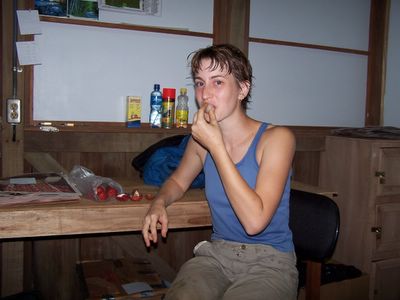The sun is just setting over the thick wall of forest behind the lab, painting the sky briefly purple. Very briefly; twilight at these low latitudes is a momentary affair. On the path below, I can see a few students walking to dinner, their headlamps already casting faint parabolas on the concrete. The high, wavering call of a tinamou floats out of the forest, just audible over the hum of the air conditioner. Today was an unremarkable day at La Selva – but I suppose that many of the things I find unremarkable would seem odd, or at least interesting, to my readers. Hence this post: a day in the life.
I woke up at 6:00 to the grunting calls of howler monkeys in the trees outside my window and the chirps of warblers, tanagers, and hummingbirds. The sun already illuminated the bank of tall trees along the river. Walking to breakfast, I watched a herd of peccaries – like very bristly pigs, with a heavy musk that reeks of old socks and rotten garlic – hoovering fallen breadfruit and guavas near the bridge. A flock of oropendolas, large black birds with yellow tails, gurgled and chortled in the trees by the river. Aside from ravens, I’ve never come across a bird with such a varied and astounding vocal repertoire as the oropendola. They make liquid warbles, chonks and gurgles like bad plumbing, and also a staticky, electrical buzzing sound that one bird book describes as being “like the ripping of fine linen.” Precisely.
Breakfast was coffee, papaya juice, cinnamon rolls, fruit (watermelon and pineapple), and the omnipresent rice and beans. Hardly a meal here goes by without a hearty serving of rice and some legume. The breakfast variety is actually my favorite: a concoction known as gallo pinto (spotted rooster), of rice and beans fried with tiny bits of sweet pepper, onions, and cilantro. A little hot sauce helps it immensely. While I ate, I talked with a group of South African student volunteers who are doing a trail condition survey and a German researcher who works on bats. Never a dull moment—breakfast conversation ranged from the best way to remove botflies (snake venom extractor, hands down), to the worst pick-up lines in several languages (hooray! New useful German phrases!).
At quarter past seven, I stopped in at the office of Proyecto Bosques, where my advisor’s assistants were preparing for a day of work. We have three great Costa Rican field assistants, Jeanette, Juan, and Bernal, who collect most of the data that my advisor uses in her ongoing investigation of forest recovery. As project manager, I’m in charge of making sure that things run smoothly and that all the materials we need for the project are ready on time. I’m also (unofficially) in charge of motivation and morale. It helps on mornings like this, when Juan has the radio tuned to the salsa station and turned up high when I come in. I start dancing. “Discomovil Bosques! Como les va, muchachos? Hoy jueves en Puerto Viejo de Sarapiquí, por un tiempo limitado, vamos a medir el diámetro de los árboles!…” (in my best imitation of the radio ads for traveling DJs and light shows that swing through the small towns of the Sarapiquí region putting on fiestas).
My assistant Bess and I left for the field a few minutes before eight, biking down the moss-slick concrete of the Sendero Tres Rios (STR). Paving the STR as a bike trail was a matter of contention here at La Selva for years. It has undoubtedly altered the hydrology – swamps have sprung up in formerly dry areas – but it has also made parts of the property available to researchers that would otherwise be inaccessible. Our destination today was one of those areas. I usually work in secondary forest, as I mentioned before, but I also have some study sites in the old growth forest as controls. This particular plot is at the back of the La Selva property, about as far as you can possibly get from the lab clearing. We biked out to the end of the STR, a little over 5k, and then hiked into the forest for about 2k on the Lindero el Peje (LEP). On the La Selva map, one quickly learns, any trail that runs straight is bad news. And trails with the word “lindero” in their names always run straight – these are the old borders of La Selva, before more land was acquired at the margins. Instead of skirting around the hills and following the topography, the straight trails go up and down the hills without any concession to negotiability. The LEP is a prime example. These days, in the rainy season, steep slopes turn into slick, red mudslides, and low-lying areas become boot-sucking mires. The back part of the LEP has another treat: a stream crossing where one has to balance on a rotting, submerged log for about eight feet, and then move fast in the mud on the far side to avoid losing a boot. (I tried to get a photo of Bess recovering her boot from the mud yesterday, but she demurred. Successful stream-crossing photos will be posted soon; stay tuned).
On the way out to LEP, a tamandua crossed the path in front of us. Tamanduas are tropical anteaters, with long funnel-shaped snouts. When startled, as this one was, they stand up to their full height of maybe a meter, rocking back and forth on their hind feet and hissing like a tea-kettle. (In the day it merely looks comical, but I’ve been very freaked out a few times coming across a defensive tamandua in the dark, alone.)
In the forest, we stashed our pack lunches in a tree to keep them out of the way of an army ant column that was marching through the plot. We spent the day marking out plots and putting tags on liana seedlings so I can follow their growth and survivorship over time. Ah, lianas. My favorite kind of plants. Woody vines, for the uninitiated. They depend on other plants for their support, which frees them up to allocate more resources to growth and reproduction. Instead of spending all their carbon to build a thick trunk and get up to the light, like boring old trees, lianas have a host of ways to scramble upwards through the canopy, moving rapidly and exploiting light much more efficiently than self-supporting plants. I like to think of lianas as the predators of the plant world, fast and smart. It’s an incredibly advantageous growth form – there are upwards of 90 plant families that contain at least one liana, and there’s strong evidence for multiple origins of the climbing habit within some families (palms, for instance). For a characteristic to evolve independently that many times, it’s got to be pretty profitable.
I’m trying to think of a way to describe our work. In the dry terms of scientific writing, it sounds pretty straightforward: we established 100 plots of 2x1 m and tagged each liana, tree, or shrub seedling in the study area. This doesn’t begin to capture the challenge of pushing through vegetation and hanging roots, up and down muddy hills, brushing away spider webs and the omnipresent clouds of mosquitos, constantly alert for snakes and stinging ants. But it’s beautiful out there, with the light filtering down through the layers and layers of leaves. The forest smells of sweet decay, with other scents drifting in and out as we walk: raw earth, orchids, dung. Water drips everywhere, even when it’s not actively raining. The sounds: parrots shrieking in the treetops, toucans playing the same two notes over and over like a broken record, water, buzzing insects, the chirp of frogs and invisible crickets overhead.
Bess and I ate sandwiches at 11, set up a few more seedling plots, and then we took a few light measurements. It’s a technique that my advisor pioneered, using the ratio of red:far-red light to estimate the amount of light that comes through the canopy. Since plants use red light for photosynthesis and not far-red light, the ratio is highly correlated with the amount of leaf tissue above the sensor, and thus with the amount of light reaching the forest understory. It’s a great technique, but it requires some expensive, touchy equipment that weighs about 35 lbs—no trivial matter, considering the journey out to the plot—and it also requires the perfect weather conditions: evenly overcast skies, with enough light coming through that the sensor won’t bottom out, but not bright enough that there are strong flecks of patchy sunlight. When Bess and I were doing a lot of light measurements in September, our definition of “good” weather was a cloudy day. There were precious few good days then – the hurricanes sucked up all the moisture from this region, giving us a freakishly dry wet season—but now, thankfully, wet weather seems to be the norm, bringing many “good” days, or at least good afternoons.
We ate our second sandwiches and chips around 3, when it got so dark in the understory that the red sensor began to flash zeros. Then we headed back, up and down the hills, crossing the treacherous stream, biking 5k in a light rain, in time to shower before supper (rice and beans, avocado, cabbage salad, green beans). And in time for me to write this, with a bit of after-dinner time thrown in. There’s music tonight—a gathering of guitars, mandolins, fiddles, and voices, mostly folk and bluegrass. It happens every once in a while, rather spontaneously. If I can manage to keep my eyes open I’ll go strum a few tunes myself. So there you have it, a day in the life.












